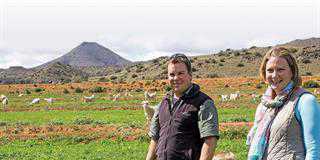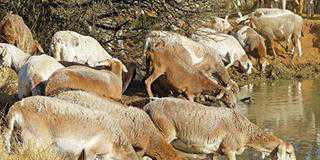Growing the country’s best mohair clip, despite diminishing global mohair production and the low potential veld conditions in his district, has always been Barries Snijman’s dream.
Barries (42) worked as a Land Bank appraiser after qualifying at Grootfontein Agricultural College in 1991 and took over Vleikuil Boerdery from his father in 1994.
Today Vleikuil Boerdery covers about 16 000ha (including leased farms) on arid Karoo veld in the Rietbron area of the Willowmore distric, where the grazing capacity is a mere 30ha/MLU (Mature Livestock Unit).
Situated in the western part of Eastern Cape, the farms average 180mm annual rainfal. Summers are hot, severe droughts is a regular occurrence and groundwater is available for irrigation but not always of the best quality. The occasional cold snap can wipe out a shorn Angora flock overnight, especially if the animals are in poor condition.
Nevertheless, Barries farms with 6 000 Angora goats and shears 17 000kg mohair a year, and recently realised an average price of R135/kg for his whole clip – nearly R40/kg more than the average for the sale on that day.
He’s also a founder member of Camdeboo Exclusive Mohair, a production system and trademark created to take high quality raw mohair through the value chain right up to the end product. It’s not surprising that he’s the Eastern Cape Agricultural Writers’ Association Farmer of the Year for 2011.
So how did Barries create a flock of veld-adapted goats under harsh, extensive veld conditions?
His ‘secret’
He stresses the importance of identifying the right adapted breeding ewes and rams. “Selecting young ewes on conformation, body size, and expected reproduction potential, using records,” he says.
“Clip quality isn’t a priority at first selection, but using the right ram is, because the wrong type will put you back genetically.”
Barries buys the best performing rams in respect of growth and veld adaption from the Willowmore Veld Ram Club. He also participates in the Grootfontein Agricultural Develoment’s study group, where farmers from the area compare their production figures.
In contrast with farmers who don’t mate their young ewes because they’re concerned about poor conception rates, Barries recently recorded a 92,6% conception rate in his ewe flock, which includes two-tooth ewes.
“This speeds up the genetic progress,” he says. He also surpasses the study group’s average kidding and weaning rates. For Vleikuil, the figures are 80,7% and 77,2% respectively.
The Angora’s ability to reproduce in harsh conditions is the most important factor for success, says Barries. But the hair eventually produced and sold is the barometer for quality in terms of length, fineness, style and character.
This is seen in his clip composition; 32,5 % is kids’ hair, 28,8% is young goat hair and 26% that of fine adults. He shears no strong adult hair, very little short hair, and markets only 12,6% of his clip as out-sorts. Only 18% of his clip tests more than 32 to 34 microns, while 23,5% is less than 25 microns.
Risk factors
“Farming well is basically managing risk factors such as unadapted breeding stock, unstable mohair prices, drought, cold and wet weather, and high land prices,” says Barries.
“Producing above-average mohair – hair superior in quality to the rest on offer – is probably the best way of managing fluctuating prices, because such lots will always attract buyers. “Good breeding must be complemented by good clip preparation. As not all types of mohair can achieve high prices, there’s room for strategic contracts with role players in the processing chain for the bigger volume segment of your clip.”
Cold snaps are a huge worry for Angora farmers. When he started farming, Barries lost half of his shorn ewe flock one icy Christmas day. Since then he’s helped develop an insurance scheme for such losses. However, he points out you need veld with natural shelter for goats.
You can also ease the impact of adverse conditions through strategic supplementary feeding and health management. Decent sheds are a must, he says. “Drought can best be handled through veld management aimed at always having enough reserve veld,” says Barries. “During drought, the dry surplus vegetation can be used with licks. Serious drought requires increased feeding levels for the nucleus flock and selling surplus animals such as castrated goats.”
Predation is another risk factor. “We use donkeys and electronic alarms to control caracals and black-backed jackal,” says Barrie. “Damage-causing animals are identified by a permanent tracker and eliminated via night shooting or helicopter.”
High land prices – relative to income potential – can be countered with long-term leases. “Strategic partnerships in property investment with the big role players in the processing chain could keep farmers in the loop,” he says.
In addition, budgeting is an important financial tool to monitor monthly spending. “Good financial advisors help in the systematic planning of balance sheets, taxes and estate duties,” adds Barries. While Angoras are his main business, there’s some diversification in the form of a small Bonsmara herd, a farm-stay in a second dwelling, and a livestock transporter. Together these make up 10% of the gross farming income.
Mentoring
Barries is in favour of BEE as it’s applied in the mohair industry, where emerging Angora farmers are mentored for two years before given the chance to go out on their own. “At the same time, farm workers need skills development and empowerment to improve their value in the work place.
“You and your family have a huge social responsibility, starting with good relationships with your staff and and the broader community,” says Barries.
Contact Barries on 044 934 1138 or email [email protected].
Caption:
Six years ago, Barries started giving breeding ewes supplements of minerals and trace elements. The vitality of their kids improved dramatically.
RYNO FERREIRA













